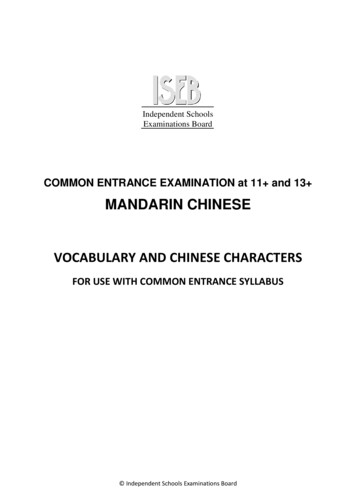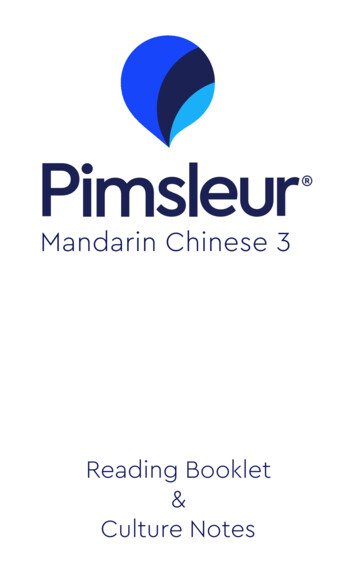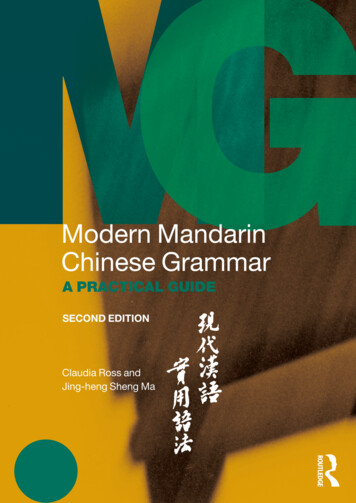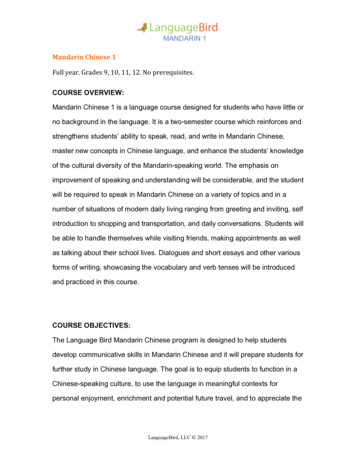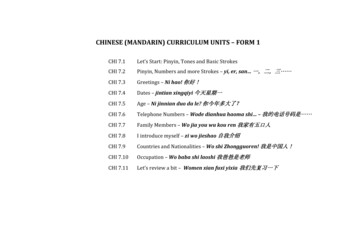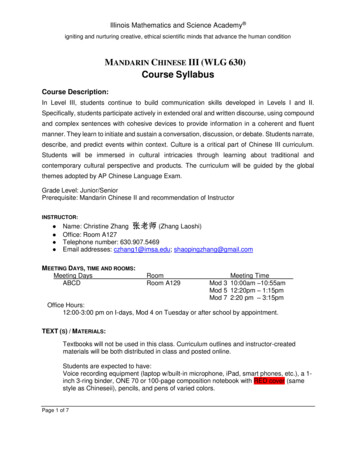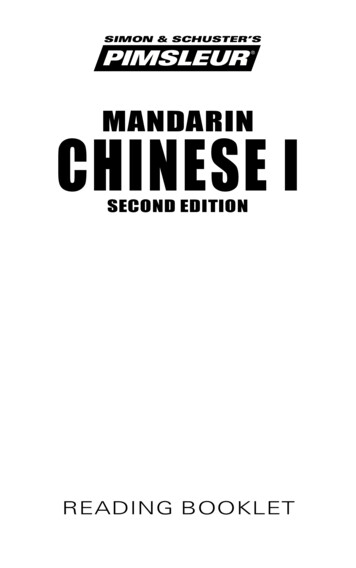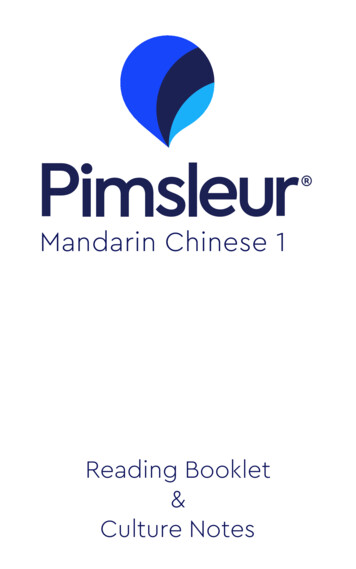
Transcription
The Praxis Study CompanionChinese (Mandarin):World Language5665www.ets.org/praxis
Welcome to the Praxis Study CompanionWelcome to the Praxis Study CompanionPrepare to Show What You KnowYou have been working to acquire the knowledge and skills you need for your teaching career. Now you areready to demonstrate your abilities by taking a Praxis test.Using the Praxis Study Companion is a smart way to prepare for the test so you can do your best on test day.This guide can help keep you on track and make the most efficient use of your study time.The Study Companion contains practical information and helpful tools, including: An overview of the Praxis tests Specific information on the Praxis test you are taking A template study plan Study topics Practice questions and explanations of correct answers Test-taking tips and strategies Frequently asked questions Links to more detailed informationSo where should you start? Begin by reviewing this guide in its entirety and note those sections that you needto revisit. Then you can create your own personalized study plan and schedule based on your individual needsand how much time you have before test day.Keep in mind that study habits are individual. There are many different ways to successfully prepare for yourtest. Some people study better on their own, while others prefer a group dynamic. You may have more energyearly in the day, but another test taker may concentrate better in the evening. So use this guide to develop theapproach that works best for you.Your teaching career begins with preparation. Good luck!Know What to ExpectWhich tests should I take?Each state or agency that uses the Praxis tests sets its own requirements for which test or tests you must take forthe teaching area you wish to pursue.Before you register for a test, confirm your state or agency’s testing requirements at www.ets.org/praxis/states.How are the Praxis tests given?Praxis tests are given on computer. Other formats are available for test takers approved for accommodations (seepage 61).The Praxis Study Companion2
Welcome to the Praxis Study CompanionWhat should I expect when taking the test on computer?When taking the test on computer, you can expect to be asked to provide proper identification at the testcenter. Once admitted, you will be given the opportunity to learn how the computer interface works (how toanswer questions, how to skip questions, how to go back to questions you skipped, etc.) before the testing timebegins. Watch the What to Expect on Test Day video to see what the experience is like.Where and when are the Praxis tests offered?You can select the test center that is most convenient for you. The Praxis tests are administered through aninternational network of test centers, which includes Prometric Testing Centers, some universities, and otherlocations throughout the world.Testing schedules may differ, so see the Praxis web site for more detailed test registration information at www.ets.org/praxis/register.The Praxis Study Companion3
Table of ContentsTable of ContentsThe Praxis Study Companion guides you through the steps to success1. Learn About Your Test.5Learn about the specific test you will be taking2. F amiliarize Yourself with Test Questions. 11Become comfortable with the types of questions you’ll find on the Praxis tests3. Practice with Sample Test Questions. 15Answer practice questions and find explanations for correct answers4. Determine Your Strategy for Success. 48Set clear goals and deadlines so your test preparation is focused and efficient5. Develop Your Study Plan. 51Develop a personalized study plan and schedule6. Review Study Topics. 55Review study topics with questions for discussion7. Review Smart Tips for Success. 59Follow test-taking tips developed by experts8. Check on Testing Accommodations. 61See if you qualify for accommodations to take the Praxis test9. Do Your Best on Test Day. 62Get ready for test day so you will be calm and confident10. Understand Your Scores. 64Understand how tests are scored and how to interpret your test scoresAppendix: Other Questions You May Have . 66The Praxis Study Companion4
Step 1: Learn About Your Test1. Learn About Your TestLearn about the specific test you will be takingChinese (Mandarin): World Language (5665)Test at a GlanceTest NameChinese (Mandarin): World LanguageTest Code5665TimeApproximately 3 hours (not including the Listening Practice section)Number of Questions75 selected-response questions and 8 constructed-response tasksFormatListening Practice section (not scored). Listening with Cultural Knowledge;6 selected-response questions (10 minutes)Section 1. Listening with Cultural Knowledge; 36 selected-response questions(50 minutes)Section 2. Reading with Cultural Knowledge; 39 selected-response questions(50 minutes)Section 3. Writing with 4 constructed-response tasks (60 minutes)Section 4. Speaking with 4 constructed-response tasks (20 minutes)Note: This test will include questions with an audio component in the Listeningand Speaking sections.Test DeliveryComputer deliveredContent CategoriesVApproximateNumber ofQuestionsApproximatePercentage ofExaminationII.IVInterpretive Listening (excludingListening Practice): includesembedded linguistic content30 selected response26%II.Interpretive Reading: includesembedded linguistic content30 selected response26%III. Cultural Knowledge: included as15 selected responsepart of Sections 1 (Listening) and2 (Reading)12%IV.Writing: Phonetic Transcription,4 constructed responseInterpersonal Writing,(writing tasks)Presentational Writing, andIntegrated Skills18%V.Speaking: Integrated Skills,4 constructed responsePresentational Speaking,(speaking tasks)Interpersonal Speaking, andPhonetic Read-Aloud18%IIIIIThe Praxis Study Companion5
Step 1: Learn About Your TestAbout This TestTest SpecificationsThis computer-delivered test is designed to measurethe knowledge, skills, and abilities of examineeswho have had preparation in a program for teachingMandarin Chinese in grades K–12. Because programsin teaching Mandarin Chinese are offered at boththe undergraduate and graduate levels, the test isappropriate for examinees at either level.Test specifications in this chapter describe theknowledge and skills measured by the test. Studytopics to help you prepare to answer test questionscan be found on page 55.The questions in the Listening section are basedon audio selections. The questions in the Readingsection are based on text selections and visual images.Questions in both the Listening and Reading sectionsare in selected-response format, and all questions andanswer choices are presented in Chinese characters.The questions and answer choices in the Listeningsection are also displayed in phonetic transcription(Hanyu Pinyin).The tasks in the Writing and Speaking sections are inconstructed-response format. In the Writing section,you will respond by typing in Chinese characters.In the Speaking section, you will respond in spokenMandarin Chinese. The tasks in the Speaking sectionare based on text and audio materials. The Writingsection uses only text materials. The Writing andSpeaking sections also include tasks that assess yourskill in writing and reading using the Hanyu Pinyinphonetic transcription system.Before the test begins, you will be asked to selecteither simplified characters or traditional charactersfor displaying Chinese text and for typing yourresponses in the Writing section. In the Readingsection, however, to assess your ability to read bothsimplified and traditional characters, some textselections and the questions based on them will bedisplayed in simplified characters only, while otherswill appear in traditional characters only, regardless ofthe preference you selected.The test may contain some questions that do notcount toward your score.I.Content Categories I, II, IV, and V –Language, Linguistics, and Comparisons(88%)A.Demonstrating language proficiency inthe target language at the Advanced Lowlevel for Listening and Speaking, and atthe Intermediate High level for Readingand Writing (both levels as described inthe American Council on the Teaching ofForeign Languages [ACTFL] ProficiencyGuidelines)The beginning Chinese (Mandarin) teacher:1. Knows how to communicate in the targetlanguage with native speakers unaccustomedto interacting with nonnative speakers, withsufficient accuracy, clarity, and precision toconvey the intended message2. Knows how to communicate in theinterpersonal mode (speaking) byparticipating actively in informal and formalconversations on topics covering home,school, leisure activities, and current events3. Knows how to communicate in theinterpersonal mode (writing) by usingChinese characters in written exchanges ondaily topics4. Comprehends in the interpretive mode(listening) main ideas and supporting detailsof audio segments, such as news items, shortstories, social notices, and reports on familiartopics that deal with factual information5. Comprehends in the interpretive mode(reading) main ideas and supporting detailsof printed texts, such as news items, shortstories, social notices, and reports on familiartopics that deal with factual information6. Knows how to read effectively andunderstand written texts in traditional andsimplified characters7. Knows how to negotiate meaning in order tosustain an interactionThe Praxis Study Companion6
Step 1: Learn About Your Test8. Knows how to move beyond literalcomprehension in the interpretive mode(listening) by inferring the meaning ofunfamiliar words and phrases in newcontexts, by inferring and interpreting thespeaker’s intent, and by offering a personalinterpretation of the message5. Knows how to exemplify the rules withexamples from the target language, such asthe verbal system, pronouns, word order, andinterrogatives, in terms of both regularitiesand irregularities6. Knows how to identify and use pragmaticand sociolinguistic conventions and register(formal and informal forms of address)9. Knows how to move beyond literalcomprehension in the interpretive mode(reading) by inferring the meaning ofunfamiliar words and phrases in newcontexts, by inferring and interpreting theauthor’s intent, and by offering a personalinterpretation of the messageC.The beginning Chinese (Mandarin) teacher:1. Knows how to identify similarities anddifferences between the target language andEnglish10. Understands the gist of normalconversational speech on a variety of topics11. Knows how to communicate in thepresentational mode (writing) by usingChinese characters to write routine socialcorrespondence, as well as coherentnarratives, descriptions, and summaries aboutfamiliar topics of a factual nature in paragraphlength in present, past, and future time12. Knows how to communicate orally in thepresentational mode (speaking) by deliveringoral presentations on familiar literary orcultural topics and by incorporatingextralinguistic support to facilitate oralpresentations that are extemporaneous orprepared but not readB.Understanding linguistics—linguisticfeatures of the target languageThe beginning Chinese (Mandarin) teacher:1. Understands the elements of phonetics andphonology and can demonstrate accuracy inpronouncing the four tones of MandarinChinese and transcribing the sounds ofMandarin Chinese using the Hanyu Pinyinphonetic transcription system2. Recognizes key cohesive devices(conjunctions and adverbs) used inconnected discourseComparison of target language withEnglish2. Knows how to contrast syntactical patterns ofsimple sentences and questions with those ofEnglishII.Content Category III – Cultures,Literatures, and Cross-disciplinaryConcepts (12%)A.Demonstrating cultural understanding—connections among the perspectives,practices, and products of the targetcultureThe beginning Chinese (Mandarin) teacher:1. Knows the three Ps:a.perspectives (such as attitudes, ideas,beliefs, and values)b.practices (patterns of behavior and socialinteraction, such as greetings, turntaking, and rites of passage)c.products (such as tools, foods, laws, art,literature, and music)2. Recognizes the value and role of authenticliterary and cultural texts—such as songs,poems, rhymes and chants, children’s books,narrative text, and novels—and the use ofthose texts to interpret and reflect on theperspectives of the target culture3. Understands high-frequency idiomaticexpressions and can infer the meaning ofwords and sentences4. Knows how to explain the rules that governthe formation of words and sentences in thetarget languageThe Praxis Study Companion7
Step 1: Learn About Your TestTest SectionsSection 2 - Interpretive Reading WithCultural KnowledgeListening Practice Section – InterpretiveListening with Cultural KnowledgeIn this section you will read a variety of text selections,such as newspaper articles and literary excerpts, inChinese. You may take notes as you read, using thescratch paper that is provided to you. Your notes willnot be graded. Each selection is accompanied by sixquestions, each with four answer choices. For eachquestion, choose the answer that is best accordingto the selection. The last two questions may test yourcultural and linguistic knowledge.This section allows you to listen to an audio selectionin Mandarin Chinese and to practice answeringquestions based on that selection in the timeallotted. This section is timed separately from theListening section that follows, and the time youspend practicing will not be counted toward the timeallotted to answering the questions in the Listeningsection. The questions in this section will NOT bescored and will NOT affect your results in any way.Section 1 - Interpretive Listening withCultural KnowledgeIn this section, you will hear a variety of audioselections, such as radio broadcasts, narratives, anddialogues, in Mandarin Chinese. Each selection will beplayed twice. After hearing a selection the first time,you will have 60 seconds to preview the questionsbefore the selection plays a second time. You maytake notes as you listen, using the scratch paper that isprovided to you. Your notes will not be graded.After listening to a selection the second time, youwill see six questions (each with four answer choices)presented one at a time. For each question, choosethe answer that is best according to the selection. Thelast two questions may test your cultural and linguisticknowledge.The questions and answer choices will be displayed insimplified or traditional characters (according to thepreference you selected) and in phonetic transcription(Hanyu Pinyin).To assess your ability to read both simplified andtraditional characters, some reading selections andthe questions based on them will be displayed insimplified characters only, while others will appearin traditional characters only, regardless of thepreference you selected.This section also includes some individual culturalknowledge questions based on visual images, such aspaintings, drawings, and photographs. In these casesthe question and answer choices will be displayed insimplified or traditional characters, according to thepreference you selected.You will have 50 minutes to complete the Readingsection. A clock at the top of the screen will show howmuch time is remaining.Cultural Knowledge Cultural knowledge questions are included aspart of Section 1 (Listening) and Section 2(Reading) Cultural knowledge questions focus onconnections among the perspectives, practices,and products of the target cultureYou will have 25 seconds to answer each question.A clock at the top of the screen will show how muchtime is remaining to answer the question. When theresponse time ends, you will automatically go on tothe next question. You will not be able to return toprevious questions.The entire Listening section lasts approximately50 minutes.The Praxis Study Companion8
Step 1: Learn About Your TestSection 3 - Phonetic Transcription,Interpersonal Writing, PresentationalWriting, and Integrated SkillsThis section includes four tasks designed to measuredifferent aspects of your ability to write in Chinese.You should respond to each task as completely andappropriately as possible. You may take notes asyou work on the tasks, using the scratch paper thatis provided to you. Your notes will not be used inevaluating your responses.For the first task (Phonetic Transcription), you willbe writing your response in Latin letters and Arabicnumerals, as you would when writing in English. Forthe remaining tasks, you will be writing your responsein Chinese characters. Use the SHIFT key (press andrelease the SHIFT key without touching any other keyon the keyboard) whenever you need to switch fromChinese input to English input or from English input toChinese input.Both Chinese text that is displayed for you to read andyour written responses to the second, third, and fourthtasks will appear in simplified or traditional characters,according to the preferences you selected.For the second, third, and fourth tasks, you will bewriting your response in Chinese characters usingthe Microsoft Pinyin Input Method Editor (IME). Youshould familiarize yourself with this input method andpractice using it before taking the test. For informationon setting up the IME, click on this link: Type inChinese, Japanese, and other character-basedlanguages.You will have 60 minutes to complete the four tasks,so you will need to pace yourself as you work in orderto allot an appropriate amount of time to each task.A clock at the top of the screen will show how muchtime is remaining. For the tasks where you will bewriting your response in Chinese characters, a counterat the top of the typing area will show how manycharacters you have typed.Your response to the Phonetic Transcription task willbe evaluated on the accuracy of your spelling andtone indicators.The Praxis Study CompanionYour written responses to the other tasks will beevaluated on the following criteria The extent to which the assigned task iscompleted Overall comprehensibility to a native speaker ofChinese who is not accustomed to the writing ofnonnative learners Accuracy and appropriateness of content Presentation of ideas in a related and logicalmanner Appropriateness of vocabulary Accuracy of grammar and mechanics Cohesiveness (including use of varied sentencestructure and transitional expression, whereappropriate) Appropriateness of register for a given taskand/or readerPhonetic TranscriptionYou will be asked to transcribe a text written inChinese characters into Hanyu Pinyin using Latinletters and Arabic numerals (to indicate tones). Atthe end of each syllable (representing one Chinesecharacter), type a numeral (1–4) to indicate the tone(no numeral for neutral tone) followed by a space(or punctuation) to separate it from the next syllable.Example: Ni3 hao3 ma?Interpersonal Writing: Response to an E-mailor LetterYou will be asked to read an e-mail or letter and towrite an appropriate response in Chinese. You shouldmanage your time to allow for planning, writing, andrevising your response. The length of your responseshould be at least 100 characters.Presentational Writing: Opinion/Position EssayYou will be asked to write an essay in Chinese on aspecific topic. Your essay should include reasonsand/or examples to support your opinion. You shouldmanage your time to allow for planning, writing, andrevising your response. The length of your responseshould be at least 200 characters.9
Step 1: Learn About Your TestPresentational Writing: Integrated SkillsYou will be asked to read a passage in Chinese andto complete a writing task based on that passage.You should manage your time to allow for planning,writing, and revising your response. The length of yourresponse should be at least 200 characters.Section 4 - Integrated Skills, PresentationalSpeaking, Interpersonal Speaking, andPhonetic Read-AloudThis section includes four tasks designed to measuredifferent aspects of your ability to speak MandarinChinese. Chinese text that is displayed for you to readwill appear in simplified or traditional characters,according to the preference you selected.You will be given specific directions for each task,including how much time you will have to prepareand how much time you will have to record yourspoken response. You may make notes as youprepare your response, using the scratch paper thatis provided to you. Your notes will not be used inevaluating your responses. For both preparation andresponse, a clock on the screen will show how muchtime is remaining.At the end of the preparation time, a tone will signalyou to begin speaking. Although you need not speakfor the entire time allotted, you should respond asfully and appropriately as possible. When the responsetime ends, you will automatically proceed to the nexttask; you will not be able to return to any previoustask. The Speaking section lasts approximately 20minutes.Your spoken responses (except for the Phonetic ReadAloud task) will be evaluated on the following criteria: The extent to which the assigned task iscompleted Overall comprehensibility to a native speaker ofMandarin Chinese who is not accustomed tointeracting with nonnative speakers Accuracy and appropriateness of content Presentation of ideas in a related and logicalmanner Appropriateness of vocabulary Accuracy of grammar and pronunciation Fluency of delivery and cohesiveness (includinguse of varied sentence structure and transitionalexpressions where appropriate)The Praxis Study Companion Appropriateness of register for a given taskand/or listenerIf you do not know specific vocabulary, you shouldtry to express yourself as well as you can, usingcircumlocution if necessary. If you make a mistake andcorrect it soon afterward, it will not be considered amistake.Your response to the Phonetic Read-Aloud task will beevaluated on the accuracy of your pronunciation andthe clarity of your reading.Presentational Speaking: Integrated SkillsYou will be asked to speak in Mandarin Chinese on atopic related to the same passage that you previouslyread for the Integrated Skills Writing task. First, youwill read and hear the topic and the requirements foryour response. You will have three minutes to reviewthe passage and prepare your response. Then you willhave two minutes to record your response.Presentational Speaking: Express an Opinion orMake an Oral PresentationYou will be asked to express your opinion or make anoral presentation in Mandarin Chinese on a specifictopic. First, you will read and hear the topic and therequirements for your response. You will have twominutes to prepare your response. Then you will havetwo minutes to record your response.Interpersonal Speaking: SimulatedConversationYou will participate in a simulated conversation inMandarin Chinese. First, you will read and hear thecontext of the conversation. Then you will have 30seconds to read an outline of the conversation: ineach pair of lines, the first line will give you an ideaof what you will hear, and the second line (markedby a dot ) will give you an idea of what you will beexpected to say. You will have five turns to participatein the conversation. Each time it is your turn to speak,you will have 25 seconds to respond.Phonetic Read-AloudTo assess your ability to read a phonetic transcriptionof Mandarin Chinese, you will be asked to read alouda passage written in Hanyu Pinyin. You will have oneminute to prepare by reading through the passagesilently. Then you will have two minutes to record yourreading.10
Step 2: Familiarize Yourself with Test Questions2. Familiarize Yourself with Test QuestionsBecome comfortable with the types of questions you’ll find on the Praxis testsThe Praxis assessments include a variety of question types: constructed response, for which you write a responseof your own; selected response, for which you select one or more answers from a list of choices or make anotherkind of selection (e.g., by clicking on a sentence in a text or by clicking on part of a graphic); and numeric entry,for which you enter a numeric value in an answer field. You may be familiar with these question formats fromtaking other standardized tests. If not, familiarize yourself with them so you don’t spend time during the testfiguring out how to answer them.Understanding Computer-Delivered QuestionsQuestions on computer-delivered tests are interactive in the sense that you answer by selecting an optionor entering text on the screen. If you see a format you are not familiar with, read the directions carefully. Thedirections always give clear instructions on how you are expected to respond.For most questions, you respond by clicking an oval to select a single answer from a list of answer choices.However, interactive question types may also ask you to respond by: Clicking more than one oval to select answers from a list of answer choices. Typing in an entry box. When the answer is a number, you may be asked to enter a numerical answer.Some questions may have more than one place to enter a response. Clicking check boxes. You may be asked to click check boxes instead of an oval when more than onechoice within a set of answers can be selected. Clicking parts of a graphic. In some questions, you will select your answers by clicking on a location (orlocations) on a graphic such as a map or chart, as opposed to choosing your answer from a list. Clicking on sentences. In questions with reading passages, you may be asked to choose your answers byclicking on a sentence (or sentences) within the reading passage. Dragging and dropping answer choices into targets on the screen. You may be asked to select answersfrom a list of choices and drag your answers to the appropriate location in a table, paragraph of text orgraphic. Selecting answers from a drop-down menu. You may be asked to choose answers by selecting choicesfrom a drop-down menu (e.g., to complete a sentence).Remember that with every question you will get clear instructions.Perhaps the best way to understand computer-delivered questions is to view the Computer-delivered TestingDemonstration on the Praxis web site to learn how a computer-delivered test works and see examples ofsome types of questions you may encounter.The Praxis Study Companion11
Step 2: Familiarize Yourself with Test QuestionsUnderstanding Selected-Response QuestionsMany selected-response questions begin with the phrase “which of the following.” Take a look at this example:Which of the following is a flavor made from beans?(A) Strawberry(B) Cherry(C) Vanilla(D) MintHow would you answer this question?All of the answer choices are flavors. Your job is to decide which of the flavors is the one made from beans.Try following these steps to select the correct answer.1) L imit your answer to the choices given. You may know that chocolate and coffee are also flavors madefrom beans, but they are not listed. Rather than thinking of other possible answers, focus only on the choicesgiven (“which of the following”).2) E liminate incorrect answers. You may know that strawberry and cherry flavors are made from fruit andthat mint flavor is made from a plant. That leaves vanilla as the only possible answer.3) V erify your answer. You can substitute “vanilla” for the phrase “which of the following” and turn thequestion into this statement: “Vanilla is a flavor made from beans.” This will help you be sure that your answeris correct. If you’re still uncertain, try substituting the other choices to see if they make sense. You may wantto use this technique as you answer selected-response questions on the practice tests.Try a more challenging exampleThe vanilla bean question is pretty straightforward, but you’ll find that more challenging questions have asimilar structure. For example:Entries in outlines are generally arranged accordingto which of the following relationships of ideas?(A) Literal and inferential(B) Concrete and abstract(C) Linear and recursive(D) Main and subordinateYou’ll notice that this example also contains the phrase “which of the following.” This phrase helps youdetermine that your answer will be a “relationship of ideas” from the choices provided. You are supposed to findthe choice that describes how entries, or ideas, in outlines are related.Sometimes it helps to put the question in your own words. Here, you could paraphrase the question in this way:“How are outlines usually organized?” Since the ideas in outlines usually appear as main ideas and subordinateideas, the answer is (D).The Praxis Study Companion12
Step 2: Familiarize Yourself with Test QuestionsQUICK TIP: Don’t be intimidated by words you may not understand. It might be easy to be thrown by wordslike “recursive” or “inferential.” Read carefully to understand the question and look for an answer that fits. Anoutline is something you are probably familiar with and expect to teach to your students. So slow down, anduse what you know.Watch out for selected-response questions containing “NOT,” “LEAST,” and “EXCEPT”This ty
Step 1: Learn About Your Test 8. Knows how to move beyond literal comprehension in the interpretive mode (listening) by inferring the meaning of unfamiliar words and phrases in new contexts, by inferring a
